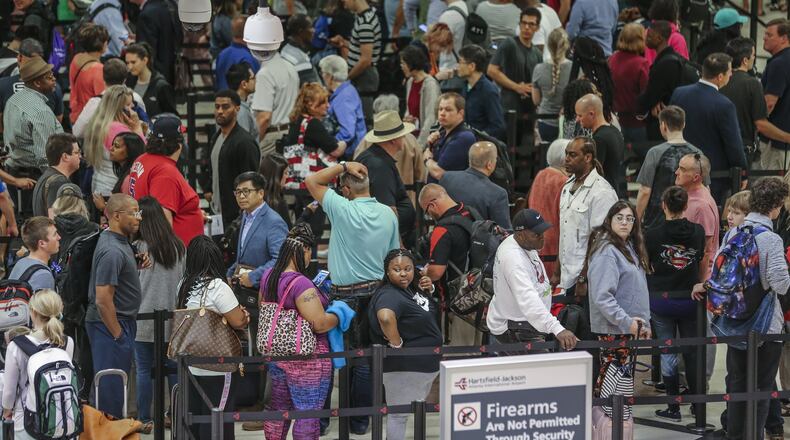How long will it take to get through security at the world's busiest airport?
Hartsfield-Jackson International wants to give a more precise answer to that question for the tens of millions of travelers who fly out of Atlanta every year.
The airport is looking for a company to handle its security wait time reporting, a task it has long done by hand in-house. But other airports around the country and the world have turned to high-tech solutions involving sensors to get more accurate wait times.
“What we want to provide is some real-time information to our passengers,” said David Washington, a senior project manager for the airport. “Right now, it’s all static; it’s all manual.”
If you check Hartsfield-Jackson's website under the current system, the estimated wait time is often listed as 0 to 15 minutes, while sometimes it's 15 to 30 minutes.
Either can be a wide range for a traveler hoping to get to the gate on time.
And it’s calculated based on a rudimentary process: Every 30 minutes, airport workers pinpoint a passenger in line — perhaps someone wearing a distinctive-looking hat who is easy to spot in a crowd — and time how long it takes for that passenger to get through the line.
Then, they update the ranges for wait time estimates displayed on the airport’s website, app and signs posted at security checkpoints.
Last Wednesday morning, for example, the airport wait time estimates were less than 15 minutes at the international terminal, 15 to 30 minutes at the domestic north checkpoint and 30 to 45 minutes at the domestic main and south checkpoints.
The Transportation Security Administration does its own internal wait-time reporting using a similar system every hour, which involves handing a laminated card to a passenger in the back of the line, who then returns it when they get to the front of the line. Other apps show user-reported wait times.
But Hartsfield-Jackson’s aim is for a new contractor to operate a much more advanced system that updates at least every 10 seconds, with “continuous detection and tracking of all passengers as they enter, progress, and exit the various queues, lanes, and checkpoint areas.”
“As the number of passengers continue[s] to increase, the Airport needs a system capable of providing passengers and airport stakeholders with accurate and timely security checkpoint wait time information,”according to city contracting documents.
The system is also supposed to detect when lanes open or close, when passengers have to stop walking after getting in line, how many passengers are in various lines — and predict future wait times, to help plan and schedule staff based on the data.
Contracting documents also specify that the system “shall use technology that is privacy complaint,” ensure passengers remain anonymous and that the system does not use facial recognition or capture personally identifiable information.
When it comes to how passengers use the data, there are some risks. That’s because wait times can change drastically between the time someone leaves home and the moment they arrive at the airport. TSA’s hourly wait time estimates can differ from the airport’s estimates made every half hour, for example.
TSA spokesman Mark Howell advised passengers checking airport wait time estimates to “use it as a planning tool – not the rule of law.” He said TSA still recommends travelers get to the airport get there two hours ahead of domestic flights and three hours ahead of international flights.
Another aim of real-time wait time estimates is to allow passengers to be able to easily choose a security checkpoint to use, according to city contracting documents.
If the wait time is shorter at one checkpoint, that can help ease crowding. Other factors may also come into play: Some security lines are for airlines' premium frequent fliers, while others are for passengers with special needs. Some lines are for members of TSA's PreCheck program for expedited screening, and others are for members of the privately-run Clear trusted traveler program. The variety of lines differs at each of the three checkpoints in the domestic terminal.
At a meeting Tuesday for companies interested in the contract, SITA — an air transport technology company with its U.S. headquarters in Atlanta — was heavily represented.
SITA has launched security wait time reporting systems at other airports around the country. In Orlando, for example, SITA says its queue management system helped reduce wait times by enabling TSA’s “rapid response to unexpected conditions.” The system uses Bluetooth, cameras and wifi sensors to calculate passenger throughput and uses algorithms to predict wait times.
Another system, Duluth-based Infax’s TRAX, uses Bluetooth detection or video and software to calculate wait times and has been installed at San Antonio’s airport.
Cincinnati/Northern Kentucky International Airport and New York John F. Kennedy International’s Terminal 4 have deployed a system called BlipTrack made by a Danish company, which also uses sensors that monitor passengers’ mobile devices.
“We know there’s a lot of technologies out there. We’re not specific to a technology,” Washington said.
The city aims to strike a deal with a new contractor and get the new system up and running sometime next year.
About the Author
Keep Reading
The Latest
Featured




